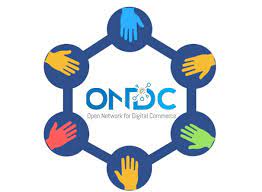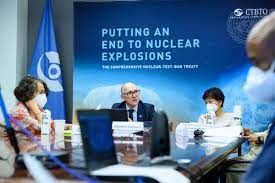What is ONDC (Open Network for Digital Commerce)

Theme: ONDC is launched in 31 December 2021 to enhance the digital ecosystem and to streamline the process of online retail operations and making it an effective choice for open networks. What is ONDC? It is an open protocol network that connects various local businesses, like transportation, grocery, food delivery, hotels, and travel, making them accessible to any app on the network. An Overview of ONDC: The Open Network for Digital Commerce (ONDC) is a bold initiative by the Government of India, aiming to revolutionize the digital commerce ecosystem by establishing a standardized and secure platform for digital transactions. In a country where over 12 million individuals derive their livelihood from dealing or reselling products and services, only about 15,000 merchants, constituting a mere 0.125% of the total, are currently involved in e-commerce. Key Objectives of ONDC: Standardised Platform: It aims to create a standardised platform, ensuring a level playing field for all participants in the digital commerce space. This not only fosters fair competition but also streamlines the overall process of online transactions. Inclusive Participation: The heart of this mission lies in inclusive participation. It strives to bridge the gap, allowing merchants from diverse backgrounds, especially those in small municipalities and rural areas, to actively engage in online retail. Safe and Secure Transactions: Emphasising the importance of trust in digital transactions, It has an strong focus on ensuring the safety and security of deals conducted through its platform. This commitment is crucial to building confidence among merchants and consumers alike. The Open Network for Digital Commerce acknowledges a unique occasion to elevate-retail presence from the current 4.3 to its maximum eventuality in India. Our charge is to significantly boost-commerce availability across the nation by easing the inclusive participation of merchandisers of all types and sizes. In December 2021, ONDC was established as a Section 8 company, with the Quality Council of India and Protean eGov Technologies Limited serving as Founding Members. Also, other institutions have invested in ONDC. Pros of ONDC: 1) Interoperability: It supports interoperability, allowing different e-commerce platforms and service providers to easily change data. 2) Fair Competition: By establishing standardized protocol it aims to produce a field for both large and small players in thee-commerce request. 3) Data Security : It maintains data security and sequestration. enforcing standardized protocols can enhance the protection of consumer data and make trust in deals. 4)Transparency: Open networks often prioritize transparency, enabling users to have better visibility into how data is collected, used, and shared. This can build trust among users. 5)Community Collaboration: Open networks often involve collaborative efforts from a community of developers, businesses, and users. Challenges: 1) Technical Implementation Issues: The transition to a standardized system across diverse e-commerce platforms may encounter technical challenges, leading to potential disruptions. 2) Balancing Act: Striking a balance between fostering innovation and ensuring compliance with regulations poses a regulatory challenge for the implementation of ONDC. Opportunities: 1)Redefining Digital Commerce: It presents an opportunity to redefine the landscape of digital commerce in India, offering a standardized and more efficient system. 2)Dynamic and Inclusive Ecosystem: The initiative has the potential to foster a dynamic and inclusive digital commerce ecosystem by encouraging interoperability and fair competition. 3)Catalyst for Positive Change: By promoting data security and transparency, this could act as a catalyst for positive change, influencing the economic landscape of the country. Conclusion: The Open Network for Digital Commerce aims to boost digital business using government-supported open networks, making things more efficient in India. But, we need to think about the challenges and possible downsides carefully. To make it work well, everyone – businesses, rules makers, and the government – must work together. Finding the right balance between new ideas, fair competition, and keeping consumers safe is crucial for the digital business to grow steadily. References: The Hindu: How to shop using ONDC? Paytm: What Is ONDC and How to Place an Order? Also Read: Conference of the Parties (COP)28 What is Comprehensive Nuclear Test Ban Treaty ? (CTBT)
What Comprehensive Nuclear Test Ban Treaty ? (CTBT)

What is Comprehensive Nuclear Test Ban Treaty ? (CTBT) Theme : “Ensuring global security: The imperative for (CTBT) Comprehensive Nuclear Test Ban.” It was adopted in 1996, aims to create a world free from the dangers of nuclear . Headline – Negotiated in the Conference on Disarmament in Geneva, the CTBT was adopted by the United Nations General Assembly in 1996. A Brief Overview The Comprehensive Nuclear Test Ban Treaty is an international treaty aimed at prohibiting all nuclear explosions for both military and civilian purposes. However, the treaty has yet to enter into force with some key countries, including nuclear-armed states, as there is no official agreement. What is Comprehensive Nuclear Test Ban Treaty? The (CTBT) has a set of rules, kind of like a big plan. This plan has three parts: Part I: International Monitoring System (IMS) – This is like a global watch system. Countries set up monitoring stations worldwide to keep an eye on nuclear activities. Part II: On-Site Inspections (OSI) – If there’s a suspicion that a country is breaking the rules, this part allows for visits to the suspicious site to check things out in person. Part III: Confidence-Building Measures (CBMs) – This is about building trust between countries. They agree to share information and be transparent to reduce the chances of misunderstandings. CTBT at a Glance: Making the World Safer from Nuclear Tests The CTBT is like a guiding light for world peace. Its main goal is to stop nuclear testing. However, it’s having a tough time becoming a rule because some big countries with nuclear weapons haven’t officially agreed to it. This is causing a problem, and the rule can’t be put into action until they agree. In a pivotal moment during the Conference on Disarmament in Geneva, the Comprehensive Nuclear Test Ban Treaty emerged, officially adopted by the United Nations General Assembly in 1996. This landmark agreement aimed to reshape the nuclear landscape, ushering in an era where all nuclear explosions, whether for military or civilian purposes, would be prohibited. Signing and Ratification: Since its opening for signature in 1996, the CTBT has garnered signatures from 185 countries. Impressively, 170 countries have ratified the treaty, showcasing widespread international support. However, the treaty’s entry into force necessitates signatures from 44 specific countries outlined in Annex 2, including nuclear-capable states like the United States, China, and India. Nuclear Testing History: Before CTBT negotiations, nuclear testing was commonplace. The Limited Test Ban Treaty (LTBT) of 1963 restricted nuclear tests in certain environments but allowed underground testing. The CTBT, in contrast, aspires to eradicate all nuclear explosions, irrespective of location. Nuclear Testing Moratorium: Despite not being in force, the CTBT has wielded influence, prompting voluntary moratoriums on nuclear testing by countries such as the United States, Russia, and China. Monitoring System: It includes a sophisticated monitoring system designed to detect and deter clandestine nuclear testing. This system, though not fully operational, showcases the commitment to transparency and accountability in the pursuit of global nuclear disarmament. Nuclear-Armed States Position: Notably, among the nuclear-armed states, China and the United States have signed but not ratified the CTBT. North Korea, India, and Pakistan have not signed the treaty, raising concerns about the efficacy of the global nuclear non-proliferation regime. Preparatory Commission The Preparatory Commission’s main job is to create a global system for checking if countries are following the rules in the Treaty. They want this system to be ready when the Treaty officially starts. They’re planning to set up a network of 321 monitoring stations and 16 labs around the world. (CTBC) Pros and Cons : Pros: 1)Nuclear Disarmament: This treaty supports global nuclear disarmament by prohibiting nuclear explosions and encouraging reductions in nuclear arsenals. 2)Prevention of Nuclear Proliferation: Aims to curb the development of new nuclear weapons, limiting the proliferation of nuclear capabilities. 3)Environmental Protection: Bans nuclear testing, protecting the environment from radioactive materials and minimizing the risk of nuclear fallout. 4) Global Security: Enhances global security by reducing the potential for nuclear arms races. 5)International Cooperation: Fosters international cooperation, promoting dialogue and collaboration toward a nuclear-free world. Cons: 1)Non-Ratification by Key States: Some major nuclear-armed states like the U.S., China, India, and Pakistan haven’t ratified the CTBT. 2)Verification Challenges: Monitoring and verifying compliance poses challenges, making detection of covert nuclear testing difficult. 3)Impact on Nuclear Deterrence: Critics argue that this may undermine the concept of nuclear deterrence, complicating reliance on nuclear weapons. 4)Technological Advances: Advances in monitoring technologies may enable clandestine, challenging-to-detect low-yield nuclear tests, reducing treaty effectiveness. 5)Uneven Commitment: Its effectiveness relies on universal commitment; non-adherence by some states creates an uneven playing field in nuclear capabilities. Conclusion: It represents effort towards nuclear disarmament and the prevention of further nuclear weapons creation. While progress has been made with widespread signatures and ratifications, the challenges lie in convincing key nuclear-armed states to fully commit. The future of the CTBT depends on the efforts to address concerns, build trust, and ultimately secure the ratifications for its entry into force References: (CTBCO): The Comprehensive Nuclear-Test-Ban Treaty: TEXT OF THE TREATY United Nations Also Read: OpenAI Ousts Sam Altman From CEO and Board Roles; Worldcoin Drops 12% Green growth – The New India
